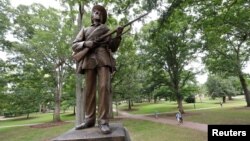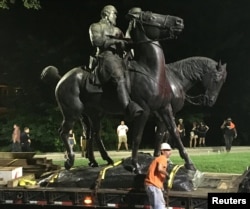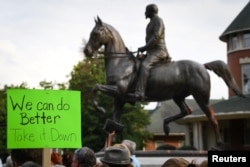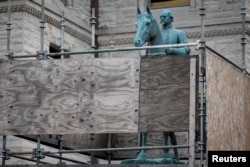As communities across the United States redouble efforts to remove Confederate monuments from public spaces after a far-right rally in Virginia turned deadly, city leaders now face another conundrum: what to do with the statues.
President Donald Trump described them on Thursday as "beautiful statues and monuments," part of the history and culture of the country that will be "greatly missed."
But they are seen by many Americans as symbols of racism and glorifications of the Confederate defense of slavery in the Civil War, fueling the debate over race and politics in America.
Cities are speeding up their removal since Saturday's rally in Charlottesville, Virginia, where a suspected white supremacist crashed a car into a crowd, killing one woman, during protests against the removal of a statue of Robert E. Lee, who headed the Confederate army in the American Civil War.
Since Monday, officials in Baltimore and Gainesville, Florida, have taken down statues, while another was torn from its plinth by protesters in Durham, North Carolina.
Calls for more to be removed have grown louder.
This has created an additional headache for cities and spurred another debate: how to dispose of the statues once they are taken down.
Some have suggested putting them in museums or Confederate cemeteries. One city councilman proposed using their metal to make likenesses of civil rights leaders.
"Melting them down and using the materials to make monuments for Frederick Douglass, Thurgood Marshall, Harriet Tubman would be powerful!" Baltimore City Councilman Brandon Scott wrote on Twitter this week. The mayor's office said that was unlikely.
Unlike Eastern Europe
The debate contrasts sharply with how Eastern Europe handled thousands of statues following the collapse of communism in the late 1980s and early 1990s. Often pulled down by angry mobs, some of the statues ended up in dumpsters and others in museums to teach people the evils of totalitarian regimes. In Budapest, a for-profit park hosts about 40 statues of communist heroes such as Karl Marx.
In the U.S. South, the debate still rages between those nostalgic for the past and those who view the monuments as painful reminders of slavery.
There are more than 700 Confederate statues in the United States according to the Southern Poverty Law Center, most of them created in the 1910s and 1920s, decades after the Civil War ended. They were intended to reassert the power of white people, said Jonathan Leib, chair of political science and geography at Old Dominion University in Virginia.
"They're visible, tangible expressions of power," he said Thursday.
In Birmingham, Alabama, Mayor William Bell ordered workers to hide a Confederate statue behind plywood boards, while the city challenges a state law banning the removal of such monuments.
"They represent acts of sedition against the United States of America and treason against the United States of America," he told Reuters on Wednesday.
But sympathies persist, as both lawmakers and citizens resist plans to remove them.
"I absolutely disagree with this sanitization of history," Kentucky Governor Matt Bevin, a Republican, told WVHU radio on Tuesday.
Proper context
For now, many of the removed statues gather dust in warehouses or, as in the case of New Orleans, sit disassembled in a city scrap yard, where two were found by local reporters.
In Baltimore, statues are now in storage, according to the mayor's spokesman Anthony McCarthy, who said they would most likely end up in a Confederate cemetery or a museum.
Many city legislators have expressed interest in relocating statues to museums, where they might be viewed as historical artifacts and not rallying points for racism.
Anna Lopez Brosche, City Council president in Jacksonville, Florida, encouraged the removal of Confederate statues from public property on Monday and proposed placing them where they will be "historically contextualized."
In Lexington, Kentucky, Mayor Jim Gray has proposed removing statues from one city park, formerly the site of a slave auction block and whipping post.
Meanwhile, a statue removed in Gainesville, Florida, on Monday is being returned to a local chapter of the United Daughters of the Confederacy, which erected it in 1904.
The group, founded in 1894 by women descended from Confederate soldiers, put up many of the statues as part of their goal to display what they call "a truthful history" of the Civil War and mark places "made historic by Confederate valor."
Some historians argue that, as in Eastern Europe, the Confederate monuments should be preserved, but in the proper context.
"A slave whipping post isn't something we want up, just out in public without interpretation," said W. Fitzhugh Brundage, American history professor at the University of North Carolina. "But on the other hand, if you have it in the Smithsonian where people can see it and it can be properly interpreted, it's a valuable teaching tool."


















